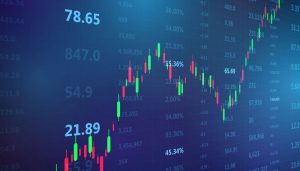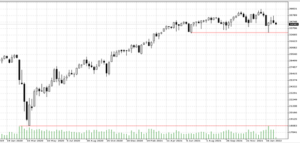

14.02.2022 – Warnings from the West are intensifying: an invasion of Ukraine is said to be imminent. Panic is likely to rage in the event of an attack.
“While the news flow surrounding Russia and Ukraine appears increasingly worrying, in reality any outcome and the impact are close to impossible to forecast,” commented portfolio manager Marcus Morris-Eyton of Allianz Global Investors. We suspect that in a worst-case scenario, prices would test the lows from the Corona crash. A lot of downside air, as the weekly chart of the Dow Jones shows.
Moscow stresses that it does not want an invasion of Ukraine under any circumstances. Moreover, Russian Foreign Minister Sergei Lavrov just calmed nerves when he answered a question from his boss Vladimir Putin in front of running cameras that there was a chance of an agreement with NATO and the US. Futures rallied; only to dive right back after a hawkish word from the Fed. The stock market is really not for the faint-hearted at the moment.
Pincer grip
But the West warns that Ukraine is encircled from three sides: In the north, Russian troops and the Belarusian army are in Belarus; in the east, Russian units are waiting on the border with Ukraine; in the south, the Russian army is said to have massed in Crimea and naval units in the Black Sea. As we have already suspected here, Russia could cut off the regions of Donetsk and Lugansk. Or immediately draw a belt in the south to create the new vassal state of Novorossia. In no time at all, about a third of Ukraine would have disappeared.
Home to the Empire
The conflict would have further possible stages of escalation: Who is to stop Vladimir Putin from drawing a corridor through Estonia, Latvia and Lithuania in the Baltic to connect the Kaliningrad/Königsberg enclave to the homeland? The weak West would cackle a little, form commissions, differentiate and kowtow at the end. Such a step would be the end of NATO – but this association is hopelessly divided anyway, since it includes appeasers who do not value armaments (Germany, Spain, Italy, etc.); furthermore, nations that are ready to defend themselves (Poland, Great Britain, USA). And who knows whether the combat-ready states will not rush to Ukraine’s aid. Then the question of a third world war would arise.
Double crisis
In any case, the blog GoldFix warned of a double crisis in Ukraine: on the one hand, a war would endanger the very existence of the European Union. The blog’s advice:
1. sell the euro
2. sell all Euro bonds to buy German Bunds, sell Euro Bonds in general
3. buy the dollar
4. buy gold- Europe more gold oriented than US and will buy it with dollars and Yen
5. sell global stocks
6. buy the yen
7. buy US bonds
8. buy eurodollars
9. sell the ruble
10. buy grains. Wheat for sure
Oil, Gold, Palladium
Second, there is a deepening international crisis beyond Europe. GoldFix’s advice:
1. buy oil- obvious
2. buy US Nat Gas- because global prices will rise and US gas might be exported… silly but people do it
3. sell stocks
4. buy gold
5. buy dollars and US bonds
6. buy yen
7. buy heating oil- it’s basically jet fuel
The blog also pointed to palladium – Russia is a bigger player in the market. Our conclusion: we hope the matter will blow over. Bernstein Bank is keeping an eye on the issue for you!
Important Notes on This Publication:
The content of this publication is for general information purposes only. In this context, it is neither an individual investment recommendation or advice nor an offer to purchase or sell securities or other financial products. The content in question and all the information contained therein do not in any way replace individual investor- or investment-oriented advice. No reliable forecast or indication for the future is possible with respect to any presentation or information on the present or past performance of the relevant underlying assets. All information and data presented in this publication are based on reliable sources. However, Bernstein Bank does not guarantee that the information and data contained in this publication is up-to-date, correct and complete. Securities traded on the financial markets are subject to price fluctuations. A contract for difference (CFD) is also a financial instrument with leverage effect. Against this backdrop, CFD trading involves a high risk up to the point of total loss and may not be suitable for all investors. Therefore, make sure that you have fully understood all the correlating risks. If necessary, ask for independent advice. CFDs are complex instruments and are associated with the high risk of losing money quickly because of the leverage effect. 68% of retail investor accounts lose money trading CFD with this provider. You should consider whether you understand how CFD work and whether you can afford to take the high risk of losing your money.

